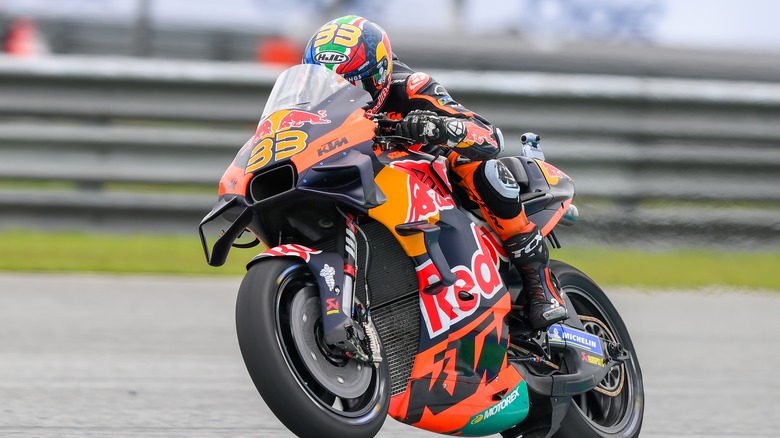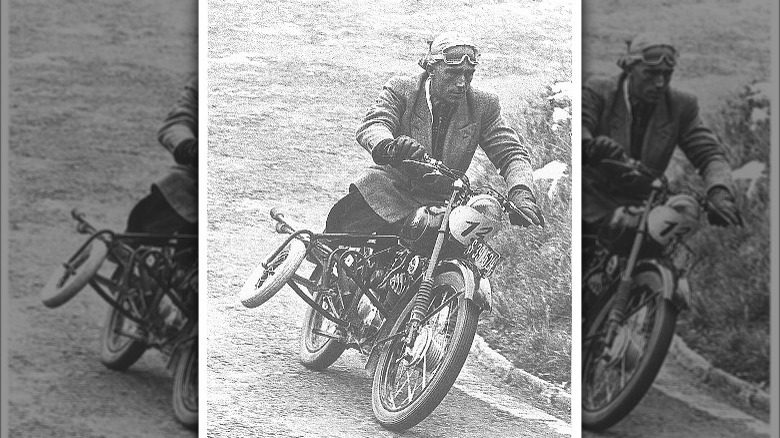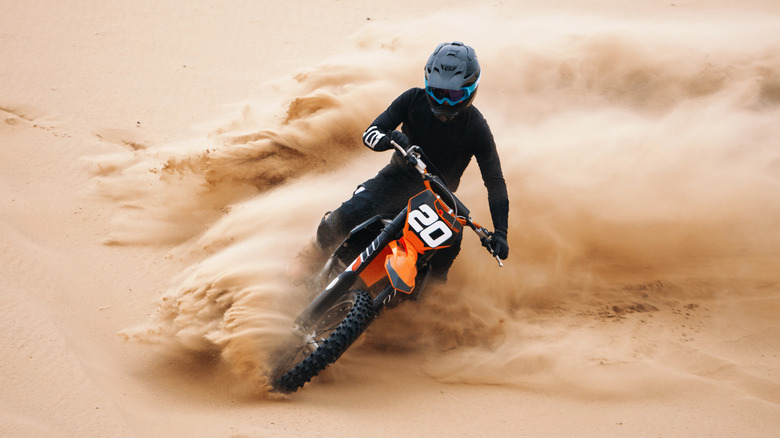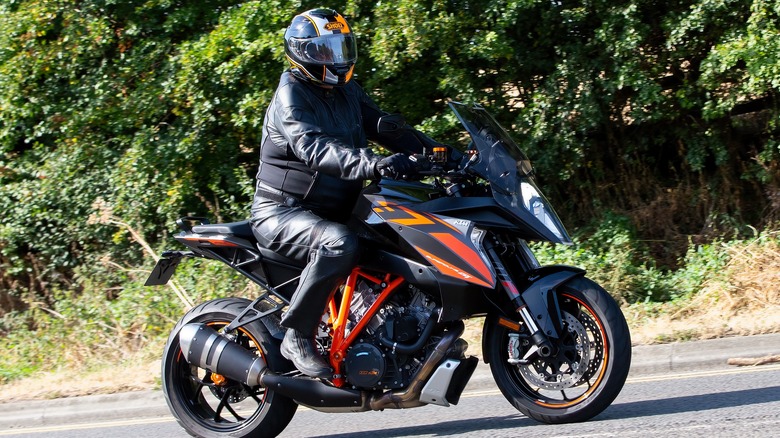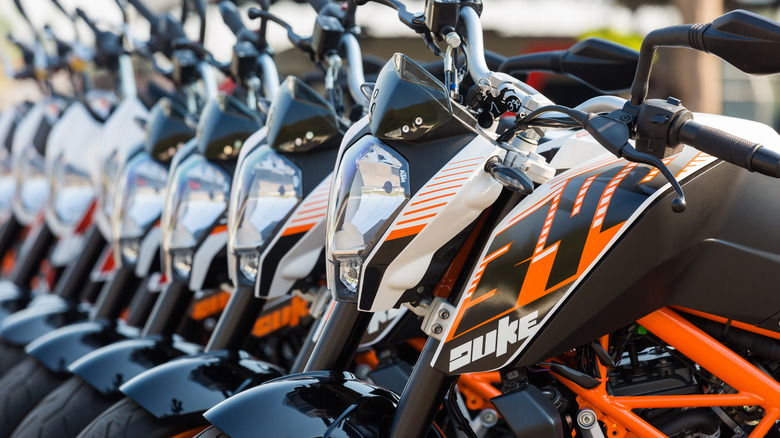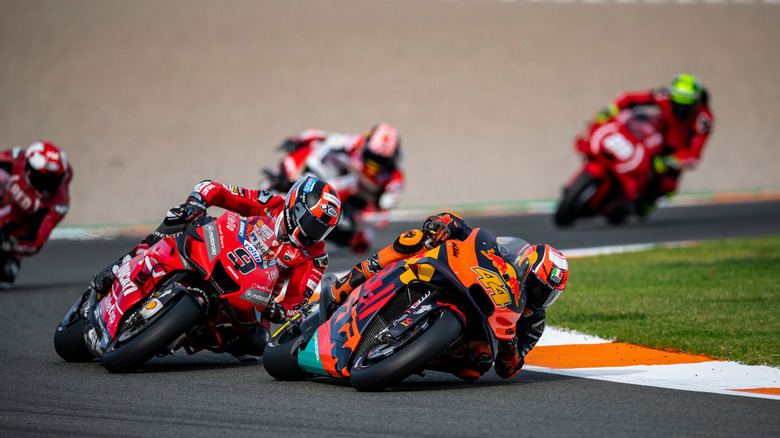Everything You Should Know About KTM Motorcycles
If you're interested in vehicles that run on two wheels, you've probably stumbled across KTM Motorcycles at some point. The company's bright orange logo certainly catches the eye, but the machine underneath shouldn't be underestimated. KTM's motorcycles are known to have some pretty stylish designs and performance to match. You might have seen one for sale on a lot, or you could have seen one out in the world. You could have spotted a rider jumping mounds, ripping down dirt trails, or even racing on the track with one.
This Austrian motorcycle manufacturer might not have the same brand recognition as some Japanese sport and dirtbike companies like Honda, Yamaha, Kawasaki, or Suzuki. Still, it's an established entity that has been around for quite some time, and it's only grown more popular over the years.
Whether you're thinking about buying a KTM bike or just curious about the company, you might be more interested in learning a little more about what sets KTM apart and how the company got where it is today. Where did it come from? What kind of motorcycles does it make? How much do they cost compared to other brands? Here's everything you need to know about KTM.
The history of KTM
KTM was founded as a metalworking shop by an Austrian engineer named Hans Trunkenpolz in 1934, and it has been designing, building, and selling motorcycles since 1951. The original full name of the business was Kraftfahrzeuge Trunkenpolz Mattighofen, with Kraftfahrzeuge translating to 'Motor Vehicle,' Trunkenpolz referring to the name of the company's founder, and Mattighofen being the name of the town in Austria where KTM was established.
The first bike KTM made was a small 100cc model called the R100. The bike was manufactured entirely out of parts that were custom-made in-house, with the exception of the Rotax engines. These were sourced from Fitchel & Sachs. KTM only had 20 employees when it started producing the R100, but they still managed to crank out about three motorcycles per day. Later that year, Trunkenpolz partnered with a businessman named Ernst Kronreif, who became a major investor. The company was renamed Kronreif & Trunkenpolz Mattighofen in honor of this partnership, which still allowed it to keep the 'KTM' abbreviation.
KTM expanded rapidly after that, introducing several new models and growing its labor force exponentially. This didn't last forever, though. KTM struggled in the '80s when Japanese manufacturers took over the market. KTM was nearly taken off the board entirely, but it had a significant comeback in 1994 after introducing the Duke sport bike and carved a new niche in performance motorcycles. KTM has maintained a consistent presence in the racing and offroad circuits in the years since and has grown substantially, now producing a wide variety of motorcycles.
KTM off-road and touring motorcycles
One of the areas where KTM has expanded the most over the years is in dirtbikes and adventure motorcycles. It is now known as one of the best dirtbike brands in the world. For those interested in off-road motorsports and exploration, the company makes bikes in nearly every size. KTM makes MX, enduro, cross-country, electric, and supermoto models, with most coming in both two-stroke and four-stroke varieties and sizes ranging from the tiny KTM 50 SX to the beefy KTM 690 SMC R. It even has smaller form factor bikes like the KTM SX-E 5 which are designed for youth riders who are looking to hit the tracks.
Then there's KTM's dual-sport and touring bikes. All-terrain motorcycles that are just as comfortable on dirt trails as on the street have grown increasingly popular in recent years, and KTM makes a couple of different varieties. Its Adventure series offers the widest variety in terms of engine size, with bikes ranging from 390cc to 1290cc. There are also several models of the same size that are tailored to different terrains. For instance, the 2024 KTM 1290 Super Adventure is more of a street bike that can handle itself off-road, while the 2024 KTM 1290 Super Adventure R is more of a dirtbike that can handle itself on the street. KTM also makes an 890 SMT touring bike, and a specialized touring version of the Duke called the 1290 Super Duke GT has a more travel-focused design for comfort over long distances.
KTM standard and sport motorcycles
Not all of KTM's motorcycles are made for getting down and dirty, though. Some of them are designed with street performance in mind. Three decades after its release, the Duke is still one of KTM's most popular models, with KTM currently offering 2023 and 2024 editions in 200cc, 250cc, 390cc, 790cc, 890cc, 990cc, and 1390cc varieties. These six-speed transmission naked bikes have garnered a reputation for their sharp, angular design, zippy acceleration, high-tech features, and some of the best cornering capabilities on the market. The larger Super Duke models have even been called some of the best KTM motorcycles ever made.
Those more interested in motorcycles they can take to the race track will probably want to look at KTM's sportbikes, though. Two new models are currently on the market: the KTM RC 390 and the KTM RC 8C. The 390 is KTM's only true commercial-grade sport bike, with a Grand Prix-inspired design and a mid-sized engine designed for performance on the street and on the track. The 8C is an entirely different animal, though. It's a brand-new prototype racer. KTM has only produced 200 units, so you probably won't be able to find it at your local dealership.
KTM Prices
Riders thinking about getting a KTM motorcycle probably want to know a bit about how much they cost. Well, if you want the short answer, KTM runs the gamut when it comes to pricing. Bikes like the KTM RC 8C and other limited-run machines such as KTM's Brabus 1300 R collaboration are all going to be prohibitively expensive for most riders, with base prices starting around 60K when units are available and resale prices potentially going even higher.
Even KTM's consumer-grade bikes can run a touch on the pricey side compared to similar bikes from their Japanese counterparts, but there's a good reason for that. For example, the smaller 2023 KTM 390 Duke runs $5,899 at MSRP. That definitely seems on the high side when compared to the 2023 Yamaha MT-03, which MSRPs at $4,999, and the 2023 Honda CB300R, which retails for $5,049, though it's nearly the same as the 2024 BMW G 310 GS, which goes for $5,890. However, KTM's non-standard engine sizes can justify this price disparity. The Duke 390's engine is a bit larger than most small-engine motorcycles. It occupies a space between the traditional small 250-300cc engines and mid-sized 500cc engines, so it makes sense that its price would reflect that.
Most of KTM's other street bikes, like the 2023 RC 39, follow a similar pricing model.
KTM's presence in motorsports
KTM builds some pretty impressive bikes, and one of the best ways the company has found to show them off on the world's stage is by putting them in competition against other motorcycles. This is where KTM has excelled, and it's a major reason for the company's success. Competitors use KTM motorcycles in major events such as MotoGP Grand Prix racing, AMA Supercross, AMA Pro National Motocross, FIM Motocross, and SuperEnduro.
KTM enjoyed 18 consecutive victories in the Dakar Rally between 2001 and 2019, and their current rider is the reigning champion, Kevin Benavides. On top of that, four KTM RC16s competed on the MotoGP grid in 2023, including one ridden by Grand Prix winner Jack Miller.
KTM's most recent victory took place in October when Josep Garcia won the 2023 Enduro1 World Cup Championship in Portugal. The racer didn't just squeak a victory, either. Garcia won with a 32-point lead and topped the EnduroGP standings. "In taking the 2023 Enduro1 title, Garcia secured his third career world championship, all achieved aboard KTM machinery," said KTM's official press release after the win. "This new title complements his Enduro2 victories from 2017 and 2021. It's been a stellar season for Josep, with an impressive nine E1 victories from the 12 days raced so far."
